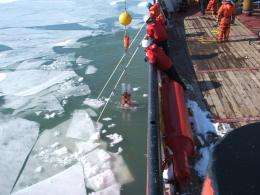Lake Erie algae, ice, make a nice mix in winter

Clarkson University Biology Professor Michael R. Twiss has been working with colleagues and students from Ohio, Pennsylvania, Tennessee and Ontario, to study Lake Erie over the past five winters during mid-winter, a time when the lake is more than 70 percent covered by ice.
Twiss and his colleagues documented very high concentrations of algae thriving in the water below the ice and even within the ice itself -- this despite dark conditions and cold temperatures that were a fraction of a degree above freezing and expected to inhibit microbial growth.
These remarkably high concentrations of algae in the surface water under the ice in winter exceed blooms of algae observed in the spring. The growth of algae in winter also removes nutrients from the water so that nutrients are lower by the time spring arrives.
Both of these observations have important implications to managing the Lake Erie sport and commercial fishery -- multi-million dollar industries in the United States and Canada.
The voyages were made possible through collaborations with the Canadian Coast Guard, which operates a Class 1 icebreaker on the lake in the winter, and the U.S. Environmental Protection Agency, which has a scientific research vessel that conducts scientific monitoring during ice-free seasons.
The research will help guide lake managers in Canada and the United States, as they consider winter conditions in attempting to understand the ecology of Lake Erie, one of five that comprise the North American Great Lakes. This collaborative research will also help the State of New York and its neighbors better manage water quality and ecosystem function in Lake Erie.
“Since Lake Erie is the shallowest of the Great Lakes, it is the both the coldest and warmest -- therefore, it is an important sentinel for climate change in the region and one we need to continue learning more about,” says Twiss.
Results of the study, "Diatoms abound in ice-covered Lake Erie: An investigation of offshore winter limnology in Lake Erie over the period 2007 to 2010," are reported by Michael Twiss, Mike McKay, Rick Bourbonniere, George Bullerjahn, Hunter Carrick, Ralph Smith, Jennifer Winter, Nigel D’souza, Paula Furey, Aubrey Lashaway, Matt Saxton and Steve Wilhelm in Volume 38, No. 1, of the Journal of Great Lakes Research, published by Elsevier, 2011.
Provided by Clarkson University














